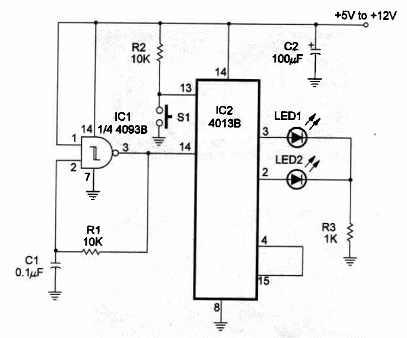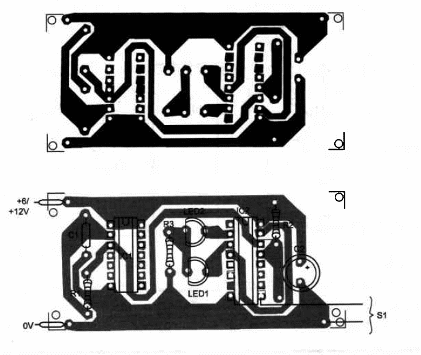This circuit simulates the flipping of a coin by merely pressing S1. Of course, the electronic version, if used for important decisions (or experiments), can’t be loaded or weighted and is 100% random.
The circuit has two LEDs that flick alternatingly, in a frequency rate determined by C1, when power is ON. When you press 81 the circuit stops immediately and only one LED remains ON.
Power supply can range from 5 to 12 volts, and this means that you can use AA cells in a portable version.
Some components can be altered according to the intended application: C1, for instance can be altered in a range from 0.01 to 0.47 µF.
You can also use a touch sensor to stop the tosser or increase R1’s value to up to 10,000,000 Ω.
The schematic diagram for the coin tosser is shown in figure 1.

Only one gate a 4093 IC is used as oscillator to produce random pulses in this circuit.
Components placement on a homemade printed-circuit board is shown in figure 2.

The circuit can easily be housed in a small plastic box.
Position of the polarized components, such as the LEDs and electrolytic capacitor, should be observed.
Coln Tosser
IC1 - 4093 CMOS Integrated Circuit
LEDs - Common red, yellow or green
S1 - SPST Momentary switch
R1, 2 - 10,000 ohm, ¼ W, 5% resistors
R3 - 1,000 ohm, ¼ W, 5% resistor
C1 - 0.1 µF ceramic or metal film capacitor
C2 - 100 µF, 16 WVDC electrolytic capacitor
Ideas to Explore
To learn more about the circuit or to get better performance:
Instead of using LEDs, transistors can be used to drive incandescent - lamps.
S1 can be placed as far as you want from the circuit. Common parallel wire can be used for this task.
Explain how a flip-flop works and how you can guarantee that the circuit is 100% random.
Science and uncommon applications:
You can conduct ESP (Extra-Sensory Perception) experiments using this circuit. S1 can be placed far from the LEDs for better results.
Experiments with probability theory can be conducted using this circuit.
Try to couple a sequence generator to the oscillator used in this circuit to get a 1-to-10 raffle circuit.




